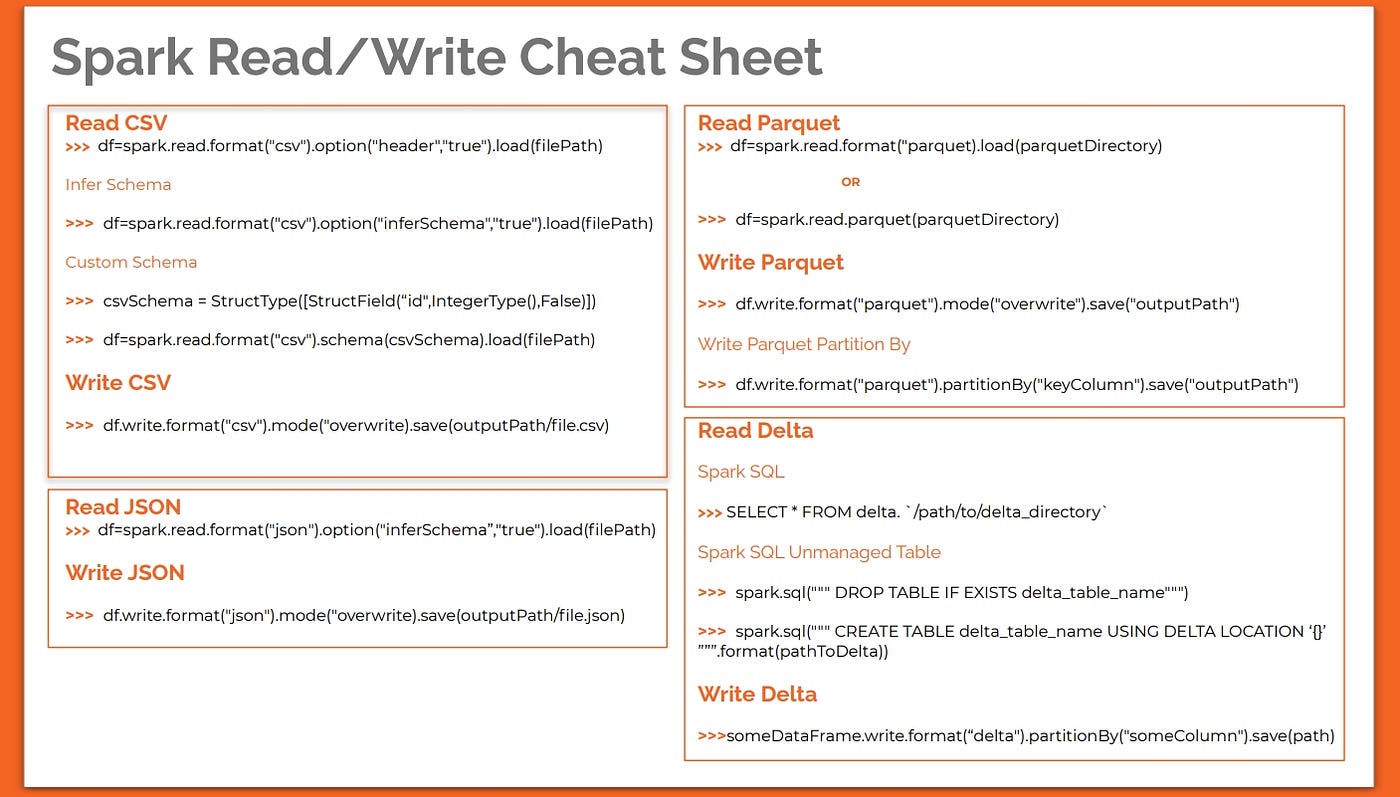Sparksession to Read Files From Arguments Scala Spark
Apache Spark Tutorial— How to Read and Write Data With PySpark
A PySpark cheat canvass for novice Data Engineers

Buddy is a novice Data Engineer who has recently come beyond Spark, a popular big data processing framework.
Considering the fact that Spark is being seamlessly integrated with cloud information platforms like Azure, AWS, and GCP Buddy has now realized its existential certainty. This has driven Buddy to jump-showtime his Spark journey, by tackling the virtually niggling exercise in a big data processing life wheel - "Reading and Writing Data"
TL;DR
Inundated with piece of work Buddy and his impatient mind unanimously decided to take the shortcut with the post-obit crook sheet using Python.

TS; WM
In hindsi yard ht, Buddy deems that it is imperative to come to terms with his impatient mind. The shortcut has proven to exist effective, simply a vast corporeality of time is existence spent on solving minor errors and handling obscure behavior.
Information technology is time to tackle the details.
Reading and writing information in Spark is a footling task, mostly it is the kickoff for any form of Big data processing. Buddy wants to know the core syntax for reading and writing data before moving onto specifics.
The core syntax for reading data in Apache Spark
DataFrameReader.format(…).choice("key", "value").schema(…).load() DataFrameReader is the foundation for reading information in Spark, it can be accessed via the attribute spark.read
- format — specifies the file format as in CSV, JSON, or parquet. The default is parquet.
- option — a set up of primal-value configurations to parameterize how to read data
- schema — optional one used to specify if you would like to infer the schema from the information source.
Read Modes — Often while reading information from external sources nosotros encounter decadent data, read modes instruct Spark to handle corrupt data in a specific mode.
At that place are 3 typical read modes and the default read mode is permissive.
- permissive — All fields are set up to nada and corrupted records are placed in a string column called
_corrupt_record - dropMalformed — Drops all rows containing corrupt records.
- failFast — Fails when decadent records are encountered.
The cadre syntax for writing information in Apache Spark
DataFrameWriter.format(...).option(...).partitionBy(...).bucketBy(...).sortBy( ...).save() The foundation for writing data in Spark is the DataFrameWriter, which is accessed per-DataFrame using the aspect dataFrame.write
Save modes — specifies what will happen if Spark finds information already at the destination.
At that place are four typical save modes and the default mode is errorIfExists
- append — appends output data to files that already exist
- overwrite — completely overwrites any information present at the destination
- errorIfExists — Spark throws an error if data already exists at the destination
- ignore — if data exists do nothing with the dataFrame
That'due south a great primer! Buddy seems to now understand the reasoning behind the errors that have been tormenting him. He would similar to expand on this noesis past diving into some of the oftentimes encountered file types and how to handle them.
CSV files
How to read from CSV files?
To read a CSV file you lot must showtime create a DataFrameReader and set a number of options.
df=spark.read.format("csv").option("header","true").load(filePath) Hither we load a CSV file and tell Spark that the file contains a header row. This step is guaranteed to trigger a Spark job.
Spark task: block of parallel ciphering that executes some task.
A job is triggered every time we are physically required to touch on the information. In this case, the DataFrameReader has to peek at the first line of the file to effigy out how many columns of data we have in the file.
When reading data you ever need to consider the overhead of datatypes. There are two ways to handle this in Spark, InferSchema or user-defined schema.
Reading CSV using InferSchema
df=spark.read.format("csv").option("inferSchema","true").load(filePath)
inferSchema option tells the reader to infer data types from the source file. This results in an additional pass over the file resulting in ii Spark jobs being triggered. It is an expensive operation considering Spark must automatically get through the CSV file and infer the schema for each column.
Reading CSV using user-defined Schema
The preferred selection while reading any file would be to enforce a custom schema, this ensures that the data types are consequent and avoids any unexpected behavior.
In guild to practise that you lot first declare the schema to be enforced, and then read the data by setting schema pick.
csvSchema = StructType([StructField("id",IntegerType(),False)]) df=spark.read.format("csv").schema(csvSchema).load(filePath)
As a result of pre-defining the schema for your data, you avoid triggering whatsoever jobs. Spark did non see the demand to peek into the file since nosotros took intendance of the schema. This is known equally lazy evaluation which is a crucial optimization technique in Spark.
How to Write CSV Data?
Writing data in Spark is adequately uncomplicated, equally we defined in the core syntax to write out data we need a dataFrame with bodily data in information technology, through which nosotros can access the DataFrameWriter.
df.write.format("csv").mode("overwrite).save(outputPath/file.csv) Here nosotros write the contents of the data frame into a CSV file. Setting the write style to overwrite will completely overwrite whatsoever data that already exists in the destination.
What you wait as a effect of the previous command is a single CSV file output, however, you would meet that the file you intended to write is in fact a folder with numerous files within information technology. This is further confirmed past peeking into the contents of outputPath.
%fs ls /outputPath/file.csv This is an important aspect of Spark distributed engine and information technology reflects the number of partitions in our dataFrame at the fourth dimension we write information technology out. The number of files generated would be different if we had repartitioned the dataFrame before writing it out.
Partitioning just means dividing a large data set into smaller chunks(partitions). In Spark they are the basic units of parallelism and information technology allows you to control where data is stored as yous write it.
JSON files
How to Read from JSON file?
Reading JSON isn't that much unlike from reading CSV files, you can either read using inferSchema or by defining your ain schema.
df=spark.read.format("json").option("inferSchema","true").load(filePath)
Here nosotros read the JSON file by asking Spark to infer the schema, nosotros only demand 1 task fifty-fifty while inferring the schema because there is no header in JSON. The cavalcade names are extracted from the JSON object'due south attributes.
To maintain consistency we can always ascertain a schema to exist applied to the JSON information being read.
jsonSchema = StructType([...]) df=spark.read.format("json").schema(jsonSchema).load(filePath)
Remember that JSON files tin exist nested and for a pocket-size file manually creating the schema may not be worth the effort, merely for a larger file, it is a ameliorate option every bit opposed to the actually long and expensive schema-infer process.
How to Write to JSON file?
As you would expect writing to a JSON file is identical to a CSV file.
df.write.format("json").fashion("overwrite).salve(outputPath/file.json) Again, equally with writing to a CSV, the dataset is split up into many files reflecting the number of partitions in the dataFrame.
Parquet files
Apache Parquet is a columnar storage format, complimentary and open-source which provides efficient data compression and plays a pivotal office in Spark Large Information processing.
How to Read information from Parquet files?
Different CSV and JSON files, Parquet "file" is actually a collection of files the bulk of information technology containing the actual information and a few files that contain meta-information.
To read a parquet file nosotros can use a variation of the syntax as shown below both of which perform the same activeness.
#option1 df=spark.read.format("parquet).load(parquetDirectory) #option2 df=spark.read.parquet(parquetDirectory)
Every bit you notice we don't need to specify any kind of schema, the cavalcade names and data types are stored in the parquet files themselves.
The schema inference procedure is not as expensive as it is for CSV and JSON, since the Parquet reader needs to process only the pocket-sized-sized meta-data files to implicitly infer the schema rather than the whole file.
How to Write data to Parquet files?
Writing Parquet is every bit piece of cake as reading it. Simply specify the location for the file to be written.
df.write.format("parquet").mode("overwrite").save("outputPath") The aforementioned partitioning rules we defined for CSV and JSON applies here.
Delta
Buddy has never heard of this before, seems like a adequately new concept; deserves a bit of background.
Delta Lake is a project initiated by Databricks, which is now opensource. Delta lake is an open-source storage layer that helps y'all build a information lake comprised of one or more tables in Delta Lake format.
It is an open format based on Parquet that brings ACID transactions into a data lake and other handy features that aim at improving the reliability, quality, and performance of existing data lakes.
In order to understand how to read from Delta format, it would brand sense to outset create a delta file.
How to Write information to Delta format?
In order to create a delta file, you must take a dataFrame with some data to be written. One time yous have that, creating a delta is as easy as changing the file type while performing a write. Instead of parquet only say delta.
someDataFrame.write.format("delta").partitionBy("someColumn").save(path)
How to Read data from Delta format?
If Delta files already exist you can directly run queries using Spark SQL on the directory of delta using the post-obit syntax:
SELECT * FROM delta. `/path/to/delta_directory`
In well-nigh cases, you would want to create a table using delta files and operate on it using SQL. The notation is : CREATE TABLE USING DELTA LOCATION
spark.sql(""" DROP Tabular array IF EXISTS delta_table_name""") spark.sql(""" CREATE Table delta_table_name USING DELTA LOCATION '{}' """.format(/path/to/delta_directory))
This is called an unmanaged tabular array in Spark SQL. It now serves as an interface between Spark and the information in the storage layer. Any changes fabricated to this table will be reflected in the files and vice-versa. In one case the tabular array is created you can query it like whatsoever SQL table.
Autonomously from writing a dataFrame as delta format, we can perform other batch operations like Append and Merge on delta tables, some of the trivial operations in big data processing pipelines.
Source: https://towardsdatascience.com/spark-essentials-how-to-read-and-write-data-with-pyspark-5c45e29227cd
Post a Comment for "Sparksession to Read Files From Arguments Scala Spark"